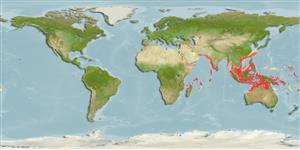分類 / Names
共通名の | 類義語 | Catalog of Fishes(部類, 種) | ITIS | CoL | WoRMS | Cloffa
Environment: milieu / climate zone / depth range / distribution range
生態学
海 関連する礁; 深さの範囲 20 - 200 m (Ref. 11441). Tropical; 30°N - 19°S
Indo-West Pacific: Persian Gulf to the western coast of India, eastward to the Pacific, where it occurs from Taiwan southward to the Arafura Sea (Ref. 9819) and northern Queensland, Australia (Ref. 3414).
Length at first maturity / サイズ / 重さ / 年齢
Maturity: Lm 21.1 range ? - ? cm
Max length : 35.0 cm TL オス/雌雄の選別がない; (Ref. 11441); common length : 25.0 cm TL オス/雌雄の選別がない; (Ref. 3483)
Inhabits coral or rocky areas. Sometimes forms aggregations. Feeds on a wide variety of benthic animals. Smaller fish are mostly found inshore. Marketed mostly fresh, whole or dried-salted.
Starnes, W.C., 1988. Revision, phylogeny and biogeographic comments on the circumtropical marine percoid fish family Priacanthidae. Bull. Mar. Sci. 43(2):117-203. (Ref. 5403)
Human uses
水産業: 少数商業の
用具
特記事項
XMLをダウンロードして下さい
インターネットの情報源
Estimates based on models
Preferred temperature (Ref.
123201): 21.9 - 28.3, mean 26.8 °C (based on 847 cells).
Phylogenetic diversity index (Ref.
82804): PD
50 = 0.5002 [Uniqueness, from 0.5 = low to 2.0 = high].
Bayesian length-weight: a=0.02138 (0.01571 - 0.02910), b=2.90 (2.82 - 2.98), in cm total length, based on LWR estimates for this species (Ref.
93245).
栄養段階 (Ref.
69278): 3.8 ±0.3 se; based on diet studies.
Generation time: 1.6 (1.2 - 1.8) years. Estimated as median ln(3)/K based on 12
growth studies.
回復力 (Ref.
120179): 高い, 15か月以下の倍増期間の最小個体群 (K=0.6-1.23).
Fishing Vulnerability (Ref.
59153): Low vulnerability (23 of 100).
Nutrients (Ref.
124155): Calcium = 53.2 [33.9, 86.8] mg/100g; Iron = 0.65 [0.42, 1.03] mg/100g; Protein = 19.3 [18.3, 20.3] %; Omega3 = 0.176 [0.124, 0.251] g/100g; Selenium = 45.4 [28.3, 74.4] μg/100g; VitaminA = 61.3 [25.2, 151.0] μg/100g; Zinc = 1.08 [0.80, 1.46] mg/100g (wet weight);
